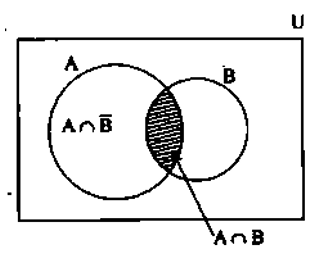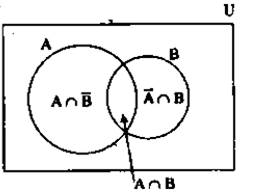prove that
(i) P(A)= P(AՈB) + P(AՈ![]() )
)
(ii) P(AՍB) = P(AՈB) + P(AՈ![]() ) + P(
) + P(![]() ՈB)
ՈB)
(i)

WE HAVE TO PROVE,
P(A)= P(AՈB) + P(AՈ![]() )
)
We know A = AՈS
We can write s = A Ս A’ and s = B Ս B’
So,
A = A Ո (B Ս B’)
= (A Ո B) Ս (A Ո B’)
Two events are mutually exclusive or disjoint if they cannot both occur at the same time.
(A Ո B) means A and B both occurring at the same time while (A Ո B’) means A and B’ both occurring at the same time.
So, it is not possible that (A Ո B) and (A Ո B’) occur at the same time.
Hence (A Ո B) and (A Ո B’) are mutually exclusive.
When events are mutually exclusive then P (A Ո B) = 0
∴ P[(A Ո B) Ո (A Ո B’)] = 0 ….. (1)
So, A = A Ո (B Ս B’)
As we know P (A Ս B) = P (A) + P(B) - P (A Ո B)
P(A) = P [(A Ո B) Ս (A Ո B’)]
= P (A Ո B) + P (A Ո B’) – P [(A Ո B) Ո (A Ո B’)]
From (1),
P(A) = P(AՈB) + P(AՈ![]() )
)
Hence proved
(ii)WE HAVE TO PROVE, P(AՍB) = P(AՈB) + P(AՈ![]() ) + P(
) + P(![]() ՈB)
ՈB)

AՍB means the all the possible outcomes of both A and B.
From the Venn diagram we can see,
AՍB = (AՈB) Ս (AՈ![]() ) Ս (
) Ս (![]() ՈB)
ՈB)
Two events are mutually exclusive or disjoint if they cannot both occur at the same time.
(A Ո B) means A and B both occurring at the same time while (A Ո B’) means A and B’ both occurring at the same time.
(![]() ՈB) means A’ and B both occurring at the same time.
ՈB) means A’ and B both occurring at the same time.
So, it is not possible that (A Ո B), (A Ո B’) and (![]() ՈB) occur at the same time.
ՈB) occur at the same time.
Hence (A Ո B), (A Ո B’) and (![]() ՈB) are mutually exclusive.
ՈB) are mutually exclusive.
When events are mutually exclusive then P (A Ո B) = 0
P [(A Ո B) Ո (A Ո B’)] =0 ….. (1)
P [(A Ո B’) Ո P(![]() ՈB)] = 0 ….. (2)
ՈB)] = 0 ….. (2)
P [(A Ո B) Ո P(![]() ՈB)] = 0 ….. (3)
ՈB)] = 0 ….. (3)
P [(A Ո B) Ո (A Ո B’) Ո P(![]() ՈB)] = 0 …. (4)
ՈB)] = 0 …. (4)
P(AՍB) = P[(AՈB) Ս (AՈ![]() ) Ս (
) Ս (![]() ՈB)]
ՈB)]
We know,
P(A ∪ B ∪ C) = P(A) + P(B) + P(C) − P(A ∩ B) − P(A ∩ C) − P(B ∩ C) + P(A ∩ B ∩ C)
So,
P(AՍB) = P[(AՈB) Ս (AՈ![]() ) Ս (
) Ս (![]() ՈB)] = P(AՈB) + P(AՈ
ՈB)] = P(AՈB) + P(AՈ![]() ) + P(
) + P(![]() ՈB) – P[(AՈB) ∩ (AՈ
ՈB) – P[(AՈB) ∩ (AՈ![]() ] – P[(AՈB) ∩ (
] – P[(AՈB) ∩ (![]() ՈB)]− P[(AՈ
ՈB)]− P[(AՈ![]() ) ∩ (
) ∩ (![]() ՈB)] + P [(A Ո B) Ո (A Ո B’) Ո P(
ՈB)] + P [(A Ո B) Ո (A Ո B’) Ո P(![]() ՈB)]
ՈB)]
From (1), (2), (3) and(4) we get,
P(AՍB) = P(AՈB) + P(AՈ![]() ) + P(
) + P(![]() ՈB)
ՈB)
Hence proved.